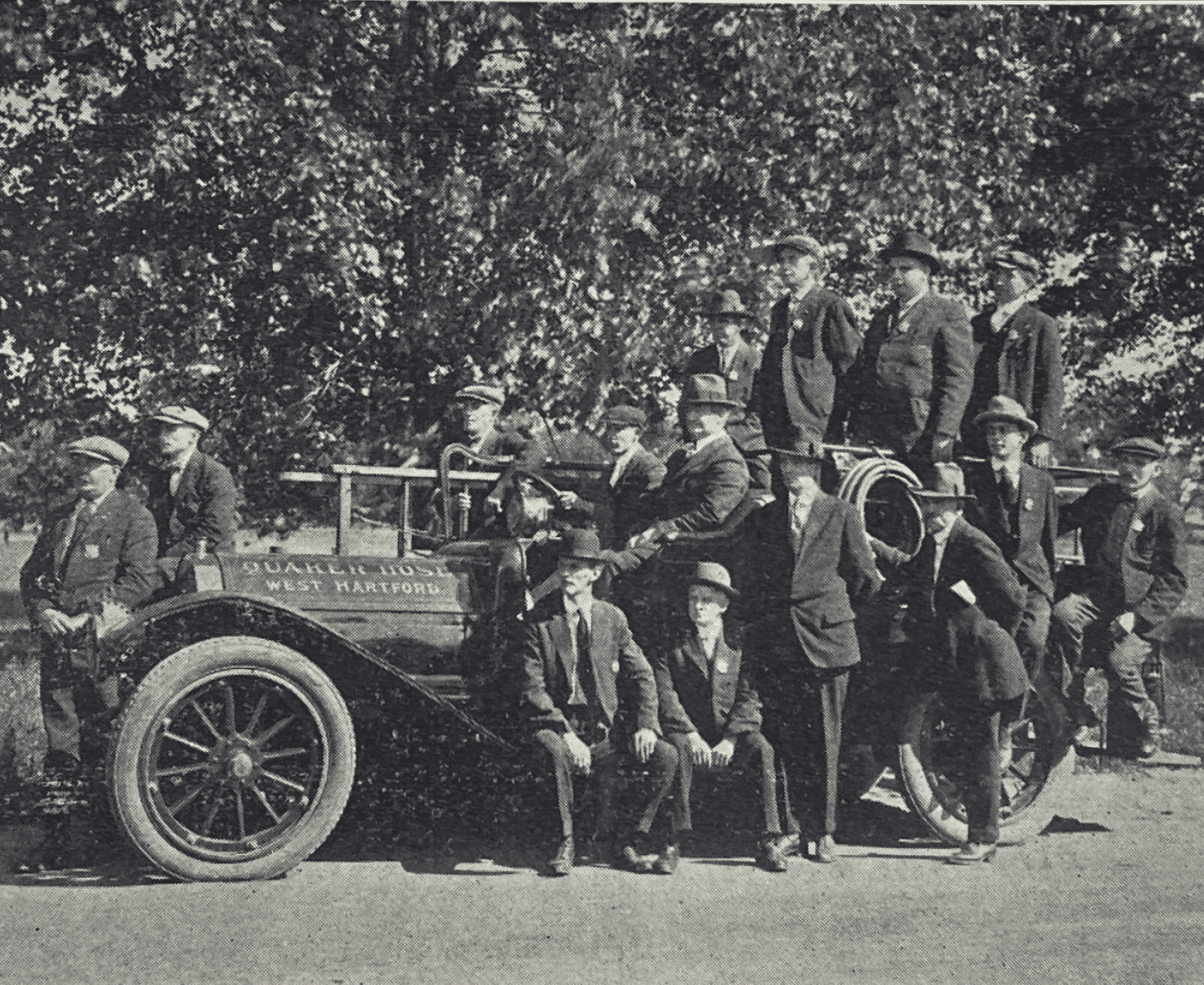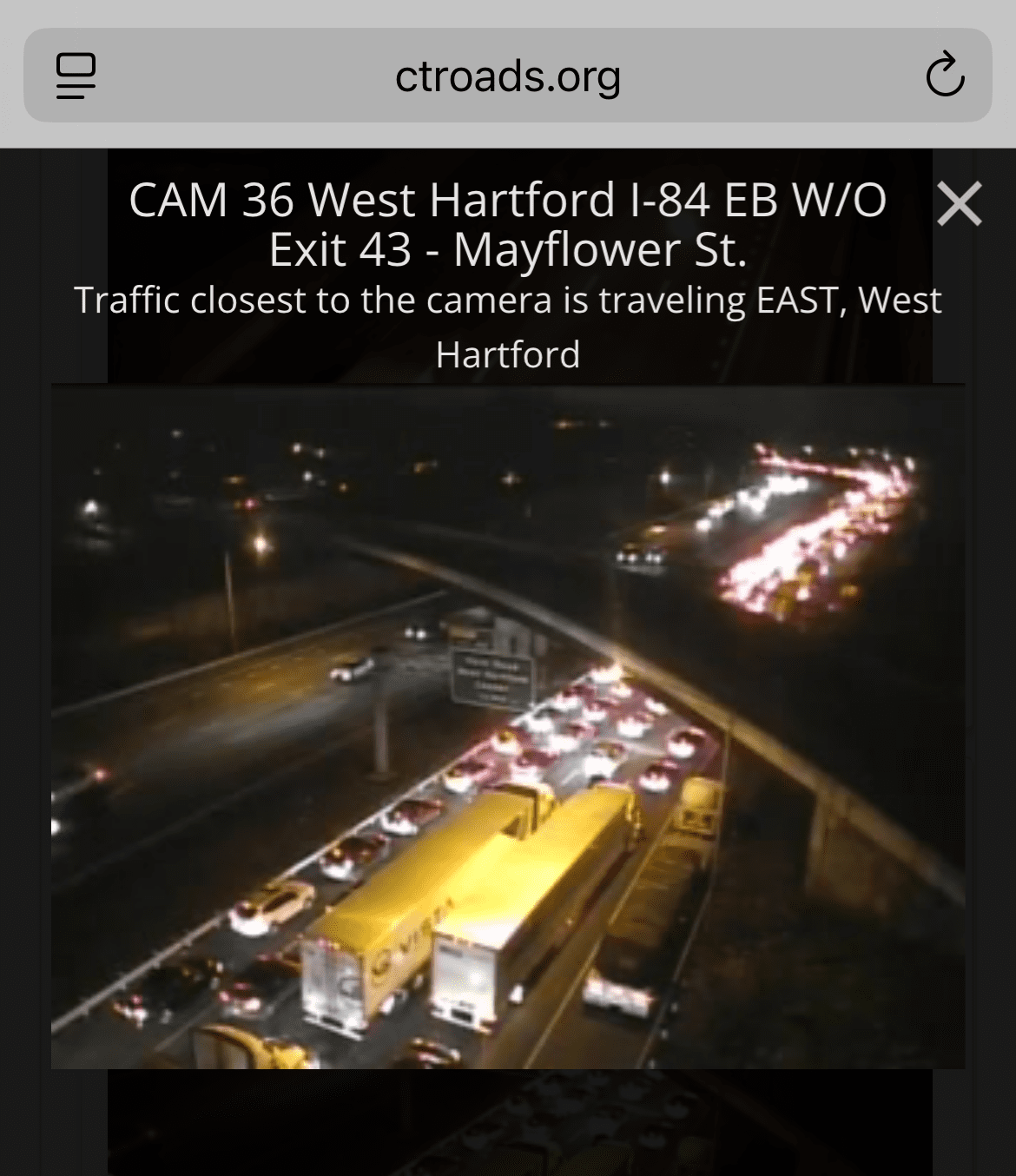From the West Hartford Archives: Quaker Hose Company

Audio By Carbonatix

Quaker Hose Company, fall of 1921. Courtesy of Noah Webster House & West Hartford Historical Society
Historian Jeff Murray takes a look into West Hartford’s past to uncover some surprising information, stir up some memories, or reflect on how much life has changed – or hasn’t changed at all. Enjoy this week’s ‘From West Hartford’s Archives’ …
By Jeff Murray
This is a photograph of the firefighters of the Quaker Hose Company in the fall of 1921. It covered the Quaker Lane area of town before the establishment of formal fire districts.
The primary reason behind the establishment of a fire company in this region came from a disastrous blaze that destroyed four homes on Raymond Road in the summer of 1907, which started from an oil stove fire in a kitchen. Members of the volunteer Fountain Hose Company (which had formed in 1879) rushed to Raymond Road (known as School Street at the time for its entrance to the high school), but the only fire hydrant in the vicinity was too far away.
The Trout Brook Ice Company, which had its plant across the street from Raymond Road on Farmington Avenue at the brook, owned a private hydrant, but the fire was at the south end of the road at the Boulevard.
As described by one of the organizers of the Quaker Hose Company later, “This fire awoke the town up to the fact that something must be done.” Preliminary steps were taken to form the Center Fire District, though that work spanned several years before it had any long-term effects.
Another fire in 1909 in a small house owned and occupied by the Busch family on Kingswood Road off South Quaker Lane brought the issue closer to home in this area. South Quaker Lane at the Boulevard was connected mainly with the members of the Busch family, who emigrated from Germany in the early 1880s after a longtime economic depression. Peter Busch, the original immigrant from that family, built a carpentry shop along South Quaker Lane in 1894 with his son Henry and developed the area of Kingswood Road, originally named Prince Street.
After the disastrous fires described above, the Busch family spearheaded an effort to organize a bucket brigade along South Quaker Lane. In December 1913, the taxpayers in the vicinity met at the local grocery store run by Joseph Busch and organized the Quaker Fire Brigade, just outside the bounds of the East Side Fire District, which had been established east to Prospect Avenue. This new brigade elected its officers: Joseph Busch as chairman; Richard M. Callahan as captain, A. Dean as assistant captain, and L. Wessel as recording secretary.
One of the first steps taken, just shy of New Year’s Eve 1913, was to purchase at least 500 feet of fire hose from the Hartford Fire Department for a brand new hydrant they would install. Money was tight early on though, and committees were sent out to solicit funds from neighbors and beyond. In a few days, enough money was procured to install two hydrants on South Quaker Lane and by the following spring, work began on connecting them at Kingswood Road and the Highlands tract (north of Kingswood).
Frank H. Stadtmueller, who had been instrumental in the formation of the Center Fire District, came out to meet with a delegation from the Quaker Fire Brigade. In October 1914, the brigade, numbering 40 members, held its first fire drill in the district to initiate its new hose wagon and apparatus. This wagon was an old milk wagon, the gift of a friend, which was remodeled with a long rope attached to the shafts. The brigade had 25 buckets to its name and had borrowed a ladder from a fellow member, but they were ready for business.
After the drill, work continued on installing hydrants at the corner of Oakwood Avenue and Park Road, and on South Quaker Lane near Park Road. The first alarm responded to was on North Quaker Lane – an old house that was destroyed. While there was no fire hydrant nearby and only a well to procure water, the new brigade managed to save the outbuildings and some furniture.
One of the lessons learned from this fire, though, was that their remodeled milk wagon was simply too slow. They held several entertainments to raise enough money to purchase something faster. In the meantime, efforts were being made across town to unify the new fire districts. The Quaker Fire Brigade, now renamed to the Quaker Hose Company, held a special meeting at the end of 1915 to consider new town regulations set by the Center District.
Most of the members agreed to the proposal to join with the other hose companies under the umbrella of a single fire district. Both Quaker Hose and the Elmwood Fire Company agreed to adopt standard rules and unite, at least in principle, with the Fountain Hose Company. However, this union was not as smooth as they hoped, when the members later found out that the merger would deprive them of representation within the fire district. Some members said they would not have agreed to the merger rules if they had known the truth two weeks earlier and that they believed the standard rules would require them to give up their identity and some of their local powers.
Some also felt pressure to accept because there were rumors that the Fountain Hose Company had unanimously accepted the same set of rules for the merger. How could the residents in the Quaker Lane district go against the will of seemingly everyone?
But it went further than identity and rumors. A committee with equal representation from the three hose companies had drafted the rules and everyone seemed to agree, but when the draft was given to the district commissioners, changes were made after the committee had already approved them. Originally, the chief and assistant chief would be elected by the companies themselves; the new changes ensured instead that they would be elected by the board of commissioners, which meant the companies would lose their power over choosing their leadership.
Ultimately, the commission was made up of members only from the Fountain Hose Company and the Elmwood Hose Company; there were none from Quaker Hose. One of the commissioners was interviewed about this disparity and they argued that there would be equal representation in the future. For now, he said, the Center Fire Department was created to unite the companies and coordinate major fires and joint activities under a single authority without the need for full representation. Everyday operations were supposed to remain independent: each company could keep its own captain as a local chief and only during large fires or joint events would the new chief have authority over all.
Claiming that the change was temporary and simply procedural seemed to calm some members and standard rules went ahead with some local autonomy for Quaker Hose. The idea of a truly unified town fire department would emerge again in a few years after another disastrous fire in the Center, but for now, things were good.
The Quaker Hose Company organized a hose house on South Quaker Lane near Kingswood Road and continued raising money for something that was faster than an old milk wagon. After saving up in the 1910s, they purchased an old Mitchell touring car. A touring car in this era was a four-door open-body automobile that could seat 5-7 passengers on two bench seats.
These types of cars were popular for early fire brigades, as well as police departments and doctors, especially to replace horse-drawn equipment. The brigade would need to transport firefighters quickly and carry hose and basic equipment, but it was really only meant for small brush fires that did not require the kind of heavy-duty luggage expected from a full house fire.
When the new car arrived, the body was quickly rebuilt to transform it into what they called a fire truck. As with the milk wagon though, it was realized that this wouldn’t be a long-term solution, especially if heavier equipment was needed. “More or less trouble was encountered in either going to or coming from a fire,” wrote Joseph Busch of the brigade. “It was finally decided to get something more substantial.”
The hose company took on a loan from the Center Fire District, solicited more funds from neighbors, and ran more fundraisers, mainly minstrel shows and carnivals. They bought a Pierce Arrow touring car, which had a more powerful engine and a sturdier frame to support ladders, hose reels, and other tools.

The Quaker Hose firehouse on Boulevard, still standing today as a residence. Courtesy photo
The company was formally incorporated in the mid-1920s and set out to build a larger (still one story) firehouse on the Boulevard, just west of South Quaker Lane. It was built entirely by members during weekends and evenings using funds solicited in the district in the winter of 1925-26. The firehouse had space for the truck in the garage as well as a social room on the ground floor.
The house was built in bungalow form “in case circumstances arise compelling its sale.” And they would indeed sell it, but operations by the company would continue for the next 40 years in one form or another.
The firehouse on the Boulevard housed the pumper truck to go to all the fires, but once the town fire department was formed in the 1930s, it no longer became necessary to stage fire equipment there. The Courant reported in 1966: “A siren would go off somewhere in West Hartford Center and men would come from all over to that little firehouse on the Boulevard in those days.”
The Quaker Hose Company kept the house, but its role transitioned from firefighting to supporting firefighting. The red firetruck was modified to use the 20,000-watt generator to supply power to emergency scenes. In 1942, when the Congregational Church burned down, the Quaker Hose Company’s emergency floodlights were used to support the firefighters.
One of the Quaker Hose captains in 1966, Warren Brown, noted that they responded not only to fires but to other accidents at night when lights were needed. For example, the company’s truck was used to power St. Agnes Home when lights went out during an ice storm in 1955 for four days. The firehouse at 1346 Boulevard had a red phone connected to the fire department switchboard at Town Hall.
The Quaker Hose Company disbanded in 1968 and the house at 1346 Boulevard was rezoned in 1970 for use as a single-family dwelling.
The featured photograph brings us back to a time before formal fire departments and instant communication. Its responsibilities may have changed over time, but the same warmth remained. As they wrote in the program for a minstrel show in 1922 to fundraise for uniforms, “We wish at this time to express to you our appreciation of the manner in which you have so generously supported our effort in behalf of better fire protection. Wishing you a very pleasant evening.”
Jeff Murray was born and raised in West Hartford and has been involved with the Noah Webster House & West Hartford Historical Society since 2011 when he was a high school student and won the Meyer Prize for his essay on local history. Jeff routinely volunteers as local history researcher uncovering information for numerous museum programs such as the West Hartford House Tour and West Hartford Hauntings. Jeff works as a data analyst at Pratt & Whitney.
Like what you see here? Click here to subscribe to We-Ha’s newsletter so you’ll always be in the know about what’s happening in West Hartford! Click the blue button below to become a supporter of We-Ha.com and our efforts to continue producing quality journalism.



